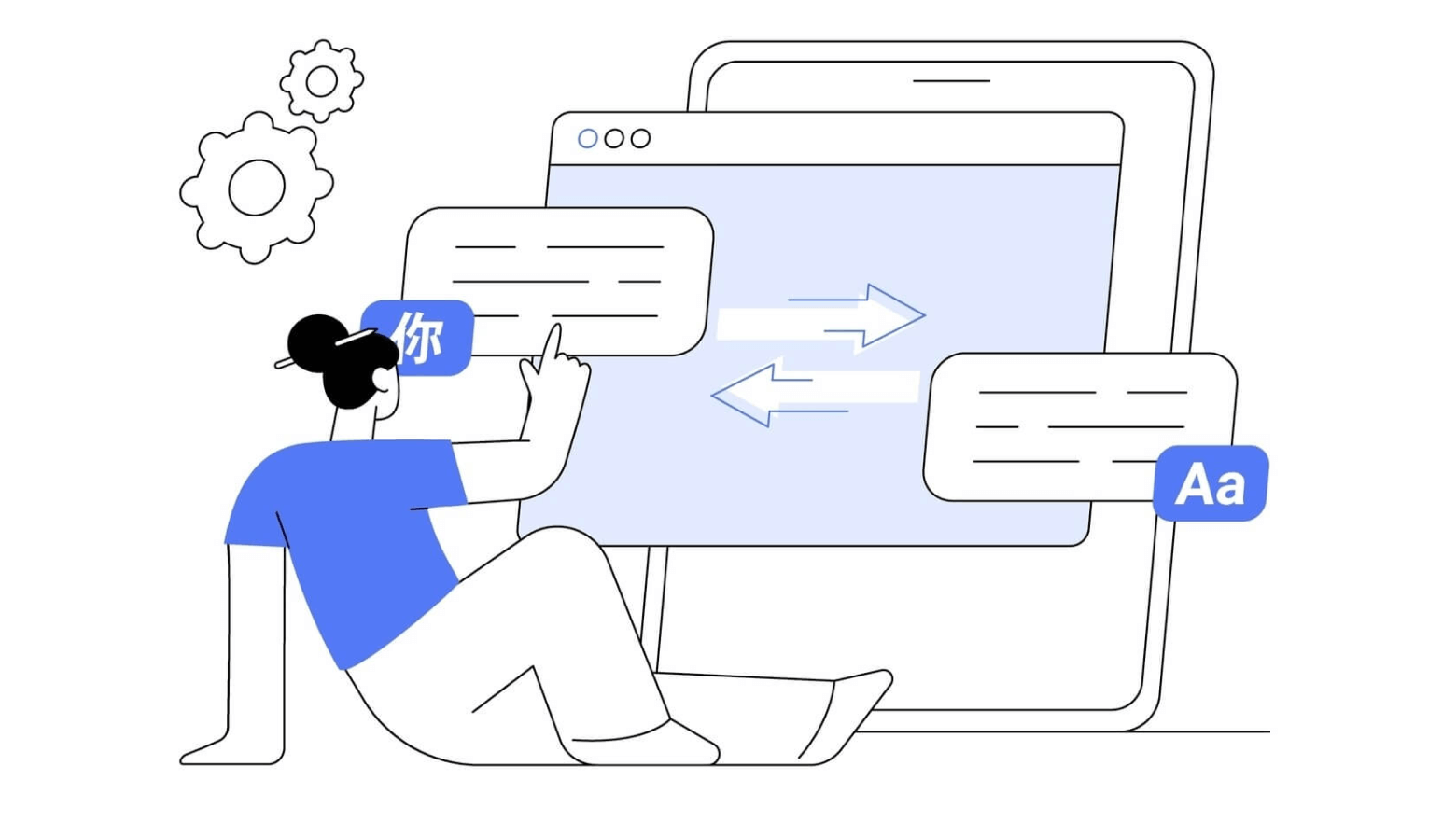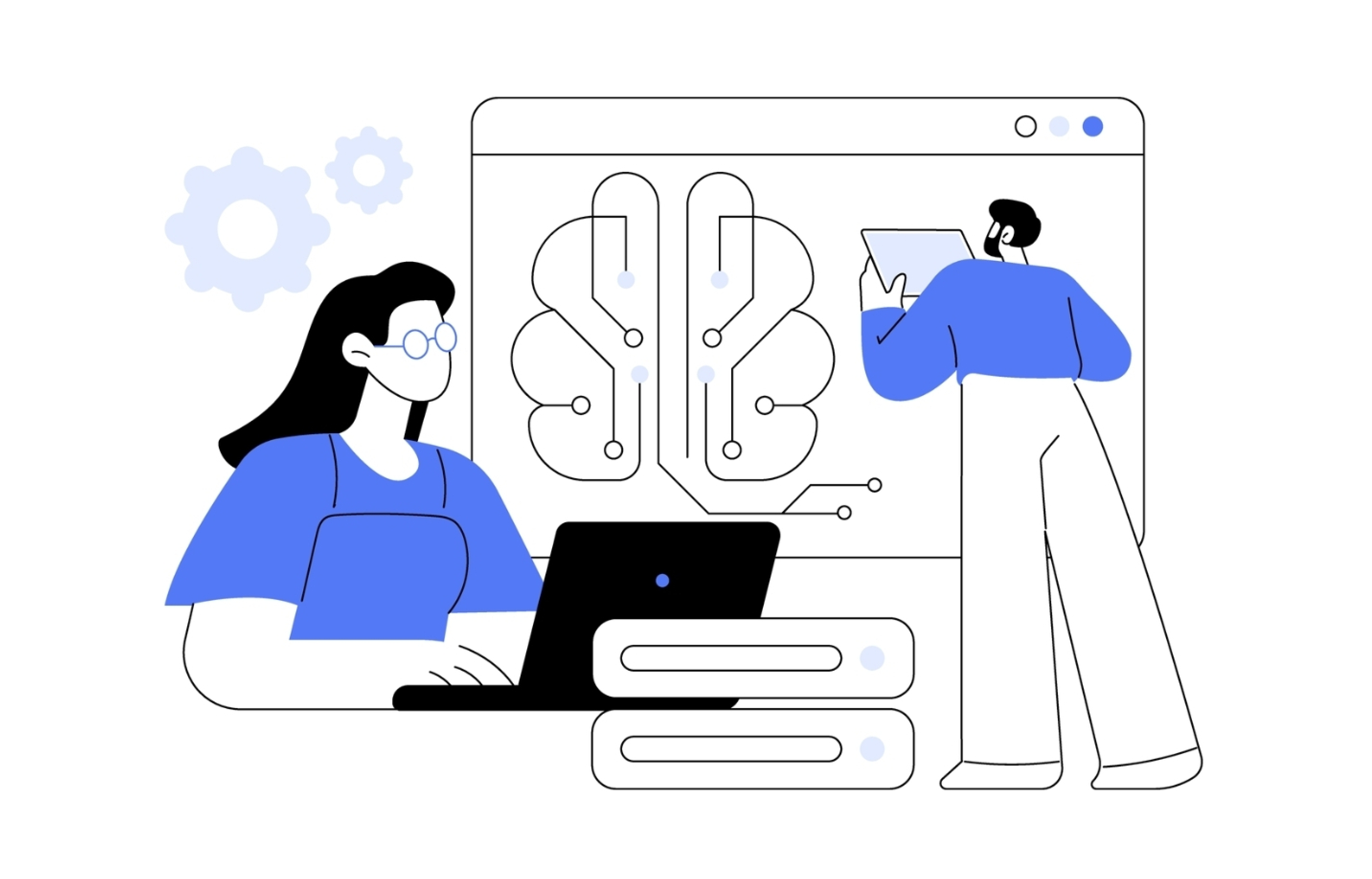In today's rapidly changing digital landscape, speech recognition technology has become a transformative factor in how we interact with devices and communicate with each other. As the applications for this technology become more numerous - from Siri and Alexa virtual assistants to advanced transcription services - understanding the nuances of different speech recognition systems is critical.
This article will look at Lingvanex’s on-premises speech recognition technology, which allows organizations to process spoken language locally on their servers. This secure and efficient alternative to cloud solutions meets the unique needs of enterprises. Key features include support for 91 languages, customizable settings for industry terminology, and fast audio processing that significantly reduces transcription times.
In addition, this article will look at how this technology can be useful in a variety of industries, from increasing employee productivity, improving customer engagement, to ensuring data privacy. By analyzing the performance of different language models, especially for less common languages, this technology demonstrates the effectiveness of Lingvanex in a variety of sectors, including customer support and education. Implementing the Lingvanex system has a number of benefits for streamlining speech recognition processes in organizations.

Brief Overview of the Lingvanex On-premise Speech Recognition
Lingvanex | On-premise Speech Recognition refers to a technology that allows organizations to process and analyze spoken language locally, using their own servers rather than relying on cloud-based solutions. Lingvanex offers an on-premise speech recognition system designed to meet the specific needs of enterprises, providing a robust and secure way to handle speech data.
Key Features of Lingvanex On-Premise Speech Recognition:
- Wide Language Support. The Lingvanex system supports 91 languages, enabling organizations to transcribe and translate spoken content across diverse linguistic needs.
- Flexibility and customization. We provide customized options to tailor the system to meet unique enterprise requirements, including the ability to customize models for industry terminology and security protocols.
- Reduced processing time. Lingvanex dramatically speeds up audio data processing, processing one minute of audio in just 3.44 seconds - significantly faster than many competing solutions.
- Improved customer experience. Lingvanex enhances customer interactions around the world by accurately recognizing different accents and dialects, as well as the ability to process multi-speaker recordings in complex and noisy environments.
- Cost savings on data processing. Lingvanex's fast processing speed and high accuracy reduce the costs associated with outsourcing transcription and other manual voice data processing tasks.
- Seamless integration into business processes. Lingvanex integrates seamlessly with existing systems via APIs and SDKs, enabling rapid implementation without the need for extensive development or modification.
- Support for multiple data formats. Lingvanex is compatible with a variety of audio formats, including common ones such as WAV and MP3, as well as more specialized formats such as OGG and FLV.
- Data Privacy and Security. For companies dealing with sensitive information, Lingvanex offers on-premises solutions that ensure full compliance with data protection regulations. Organizations can process sensitive documents offline, minimizing the risk of data exposure since no information is transmitted outside the company’s infrastructure.
- Unlimited Transcription. Organizations can enjoy unlimited transcription capabilities for a fixed monthly price, starting at €400. This pricing structure allows for extensive use without incurring additional costs based on volume.
Lingvanex Local Speech Recognition Performance Review
This work was conducted with the aim of comparing the translation performance of different language models for several language pairs, namely English, Spanish, Portuguese, French, German, Arabic.
When evaluating translation quality, we used two key metrics: Word Error Rate (WER) and Character Error Rate (CER). WER measures the number of incorrect words in the translation compared to the source text, expressed as a percentage. The lower the WER, the more accurately the system recognizes speech. CER, on the other hand, evaluates the accuracy of the translations at the character level, also expressed as a percentage. A lower CER indicates that the system recognizes speech more accurately. Both metrics provide insight into the performance of the language models under test.
For English, the tuned_small model achieved a WER of 9% and a CER of 4%, while the large-v3 model had a WER of 58% and a CER of 44.5%. This results in a difference of 49% for WER and 40.5% for CER.
For Spanish, the tuned_small model performed better with a WER of 11% and a CER of 5%, compared to the large-v3's WER of 68% and a CER of 45%, showing differences of 57% and 40%, respectively.
In French, the tuned_small model had a WER of 10% and a CER of 5%, while the large-v3 model scored 60% for WER and 38.5% for CER, resulting in differences of 50% and 22.5%.
For German, the tuned_large model achieved a WER of 28% and a CER of 30%, compared to the large-v3's WER of 57.8% and a CER of 30%, indicating differences of 28% for WER and no difference for CER.
In Arabic, the large-v3 model had a WER of 4% and a CER of 52%, while the tuned_large-v2 model scored 4% for WER and 2.2% for CER, leading to differences of 0% for WER and 49.8% for CER.
Lastly, for Portuguese, the tuned_large-v2 model achieved a WER of 10% and a CER of 35.3%, while the large-v3 had a WER of 51.86% and a CER of 26%, resulting in differences of 41.86% for WER and 9.3% for CER.
Overall, the analysis showed varying levels of performance across the different models and languages tested, with the tuned_small and large-v3 models showing noticeable differences in WER and CER. This suggests that tuning the model significantly improved the performance, which ultimately resulted in high-quality speech recognition for such rare languages.
Below are tables summarizing the Word Error Rate (WER) and Character Error Rate (CER) for six languages (Spanish, Portuguese, French, German, Arabic and Hindi). The difference column shows the performance difference between the large-v3 model and the corresponding tuned model.
Table 1: Word Error Rate (WER%)
| Language | Tuned Model | WER (%) Tuned | WER (%) Large-v3 | Difference |
|---|---|---|---|---|
| English | tuned_small | 9 | 58 | 49 |
| Spanish | tuned_small | 11 | 68 | 57 |
| French | tuned_small | 10 | 60 | 50 |
| German | tuned_large | 8 | 36 | 28 |
| Arabic | large-v3 | 4 | 52 | 48 |
| Portuguese | tuned_large-v2 | 10 | 32 | 22 |
Graph 1 - Word Error Rate (WER) Comparison
lower bars = better performance
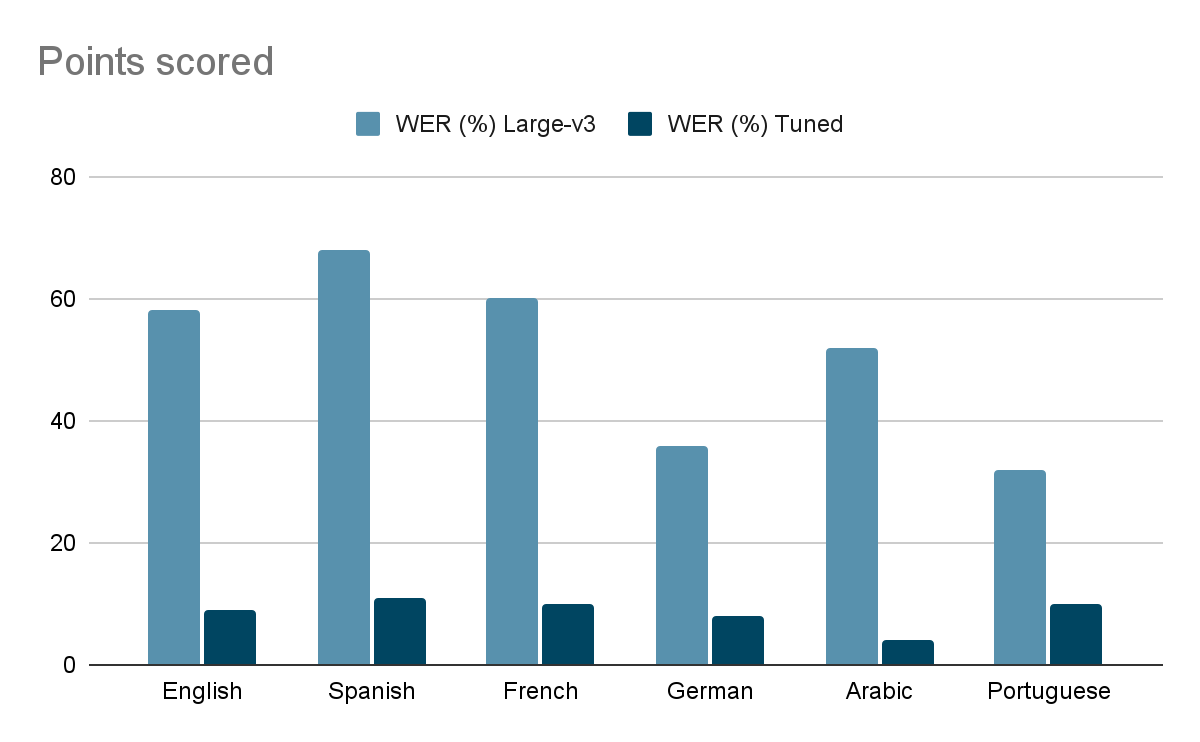
Table 2: Character Error Rate (CER%)
| Language | Tuned Model | CER (%) Tuned | CER (%) Large-v3 | Difference |
|---|---|---|---|---|
| English | tuned_small | 4 | 44,5 | 40,5 |
| Spanish | tuned_small | 5 | 45 | 40 |
| French | tuned_small | 5 | 38,5 | 22,5 |
| German | tuned_large | 3 | 30 | 28 |
| Arabic | large-v3 | 4 | 25 | 21 |
| Portuguese | tuned_large-v2 | 4 | 35,3 | 31,3 |
Graph 2 - Character Error Rate (CER) Comparison
lower bars = better performance
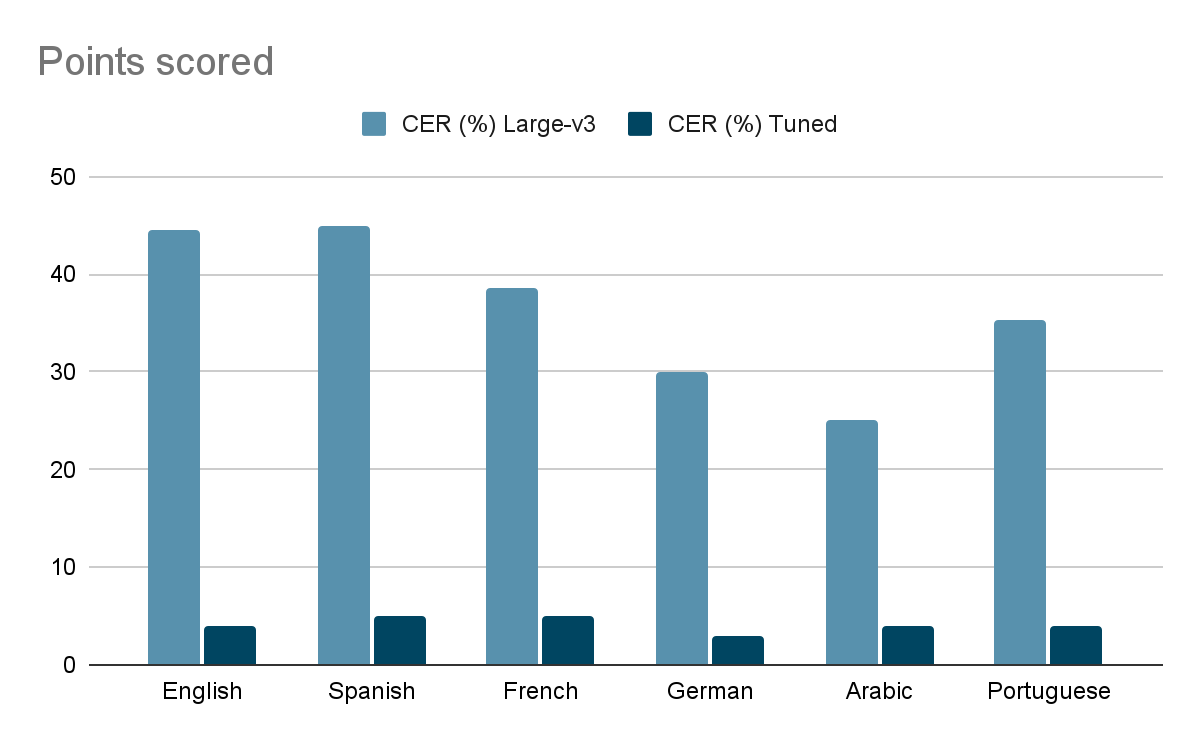
Lingvanex Testing
When it comes to speech recognition, accuracy and adaptability are critical. The chart above demonstrates the high performance of our models on par with leading competitors in the market such as Google, Microsoft, Amazon and Yandex. Testing was conducted on real data for several languages: English, Spanish, French, German, Arabic and Portuguese.
WER Score Comparison
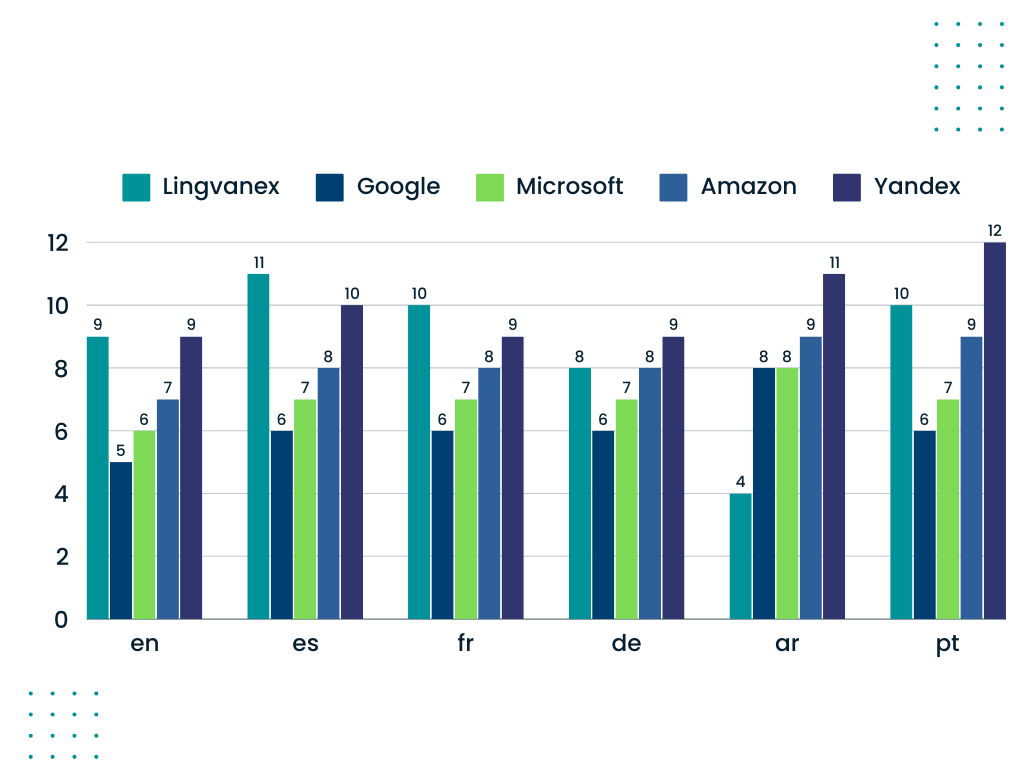
СER Score Comparison

The diagram shows the results of testing using the ready-made Lingvanex solution. Already at this stage, the system demonstrates a high level of translation accuracy and text processing, which makes it effective for solving a wide range of tasks.
Unlike one-size-fits-all solutions, our models are designed with customization in mind. We excel at customizing speech recognition systems to meet unique customer requirements, delivering context-relevant results that are relevant to specialized domains such as healthcare, finance, and education. Our solutions are significantly more cost-effective while maintaining top-notch performance, making our offering accessible without compromising value. Thanks to this setup, the Lingvanex system can further improve productivity by adapting to the client's stylistic, terminological and lexical preferences. This personalized approach allows for increased speech recognition accuracy and improved perception of the final text, making Lingvanex an indispensable tool for companies working in specialized fields.
Use Cases
The Lingvanex On-Premise Speech Recognition System offers a versatile solution for a variety of sectors. The technology improves productivity and availability by providing reliable transcription services tailored to the unique needs of different industries. Here are some key examples of how Lingvanex can be used to improve operations, facilitate collaboration, and drive innovation:
- Customer Support. Businesses can use Lingvanex to transcribe customer support calls and chats, allowing them to better analyze customer feedback and improve customer service. The system's ability to understand different accents and dialects ensures effective communication.
- Content Creation for Marketing. Marketers can record brainstorming sessions and transcribe them with Lingvanex to generate new content ideas. This can lead to more creative campaigns derived from spontaneous discussions.
- Education and E-learning. Educational institutions can use Lingvanex to transcribe lectures and seminars, making content more accessible to students. The technology can also help in subtitling online courses, enhancing learning.
- Sentiment Analysis of Customer Feedback. Lingvanex can transcribe customer feedback from calls or surveys, allowing companies to analyze sentiment trends over time. This information can guide product development and customer service improvements.
- Accessibility for Hearing-Impaired Employees. Companies can use Lingvanex to provide real-time transcriptions of meetings and presentations, ensuring that hearing-impaired employees can fully participate and engage in work discussions.
- Multilingual Communication in Global Teams. In multinational companies, Lingvanex can facilitate communication by transcribing and translating conversations in real time, helping teams collaborate more effectively despite language barriers.
- Social Media Monitoring: Companies can analyze customer conversations on social media platforms by transcribing audio or video content. This allows them to better understand public sentiment and trends related to their brand.
Why Choose Lingvanex?
With seven years of experience, Lingvanex prioritizes quality and innovation. Here are some of the key features that define our company:
- Consistent Technical Support. Our group of specialists are available to assist you with any problems or questions you may have. This ensures that your translation requests are handled efficiently, saving you time and effort.
- Ongoing Model Training. Lingvanex is committed to continuous improvement. We frequently update and improve our translation models using the latest technology. This constant development results in more accurate translations.
- Skilled Professionals. Our linguists aren't only multilingual, but also have specialized cultural knowledge. This knowledge ensures that technical terms, nuances and cultural context are reflected in our translations.
- Feedback system. We actively collect feedback from our users, which plays a crucial role in improving our services. With this, we can make changes when training models that will meet their needs and preferences.
- Advanced speech recognition technology. Using advanced speech recognition algorithms and an extensive database allows us to make our recognition accurate not only linguistically, but also context-aware.
Conclusion
In summary, Lingvanex | On-premise Speech Recognition technology offers businesses a powerful solution for secure and efficient speech processing. Supporting 91 languages and providing customizable settings, it increases productivity, improves customer engagement, and ensures data privacy. The ability to seamlessly integrate into existing systems and quickly transcribe makes it an ideal choice for a variety of industries. When choosing a speech recognition system, businesses should consider many factors: from accuracy and noise immunity to multi-language support and integration flexibility. If you are looking to improve key processes based on voice data and want to see real results, not theoretical promises, Lingvanex will be your reliable partner.

